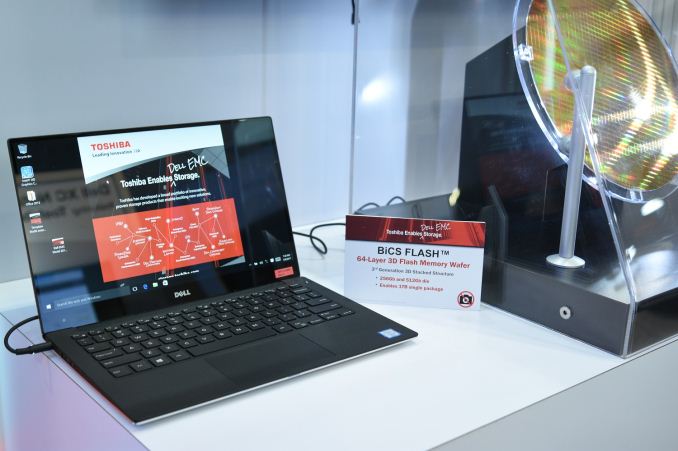Toshiba Demonstrates NVMe SSD With 64-Layer BiCS3 3D NAND
by Billy Tallis on May 8, 2017 9:00 AM EST
Toshiba's transition from planar NAND flash to 3D NAND flash memory has been a long, drawn-out process. Their BiCS 3D NAND architecture is on its third generation but has yet to have any significant impact on the SSD market. The first generation of BiCS 3D NAND was never mass produced. The second generation 256Gb 48-layer BiCS2 3D NAND has seen some use in memory cards and smartphones, but its only presence in the SSD market has been the BG series—a relatively low-volume OEM-only line of BGA SSDs. It's enough to prove that their 3D NAND isn't vaporware, but hasn't done anything to alleviate the ongoing global NAND shortage or push prices down. Toshiba's third generation 3D NAND is planned to be the one that finally displaces planar NAND, with a 512Gb 64-layer TLC part that should be able to beat the price/GB of Toshiba's 15nm planar TLC, and a smaller 256Gb part for lower-capacity applications like memory cards.
This week Toshiba is publicly demonstrating for the first time a SSD using their 64-layer BiCS3 3D NAND. At the Dell EMC World conference, Toshiba has a live demo of a laptop containing a prototype XG-series NVMe PCIe SSD with a total of 1TB of BiCS3 3D TLC NAND. Toshiba's XG3 series is the OEM counterpart to the OCZ RD400 consumer NVMe drives. Toshiba won't comment on how the XG prototype differs from the RD400 or XG3 aside from using 3D NAND, but the prototype probably offers an early look at what the next XG will feature when it is ready to be officially announced. The prototype is a model that is currently sampling to large OEMs and could be formally announced in just a few months.
Toshiba has announced that they intend to migrate all of their SSD product lines to their 3D TLC NAND, starting with OEM and enterprise products before rolling out to the retail market. They are not willing to commit to a particular timeline for completing the transition, but we should see multiple models announced and shipping by the end of 2017. Supply will continue to be a concern as new 3D NAND fab capacity comes online in 2018, and that's when we might see the current flash memory shortage wrap up and SSD prices resume a healthy decline.











10 Comments
View All Comments
vladx - Monday, May 8, 2017 - link
Finally, now I wonder how long until Toshiba actually announces the new products and releases them under OCZ brand as well.HomeworldFound - Monday, May 8, 2017 - link
If I were Toshiba I'd never make a product with the OCZ brand ever again. It's too tainted.tuxRoller - Tuesday, May 9, 2017 - link
Do you think there's ever a point where one could say "I'm comfortable with this taint"?BrokenCrayons - Tuesday, May 9, 2017 - link
I'm comfortable with this taint. So yeah, I think some of us are already at that point.vladx - Tuesday, May 9, 2017 - link
Well that's your opinion, for me just knowing it's basically Toshiba tech plus OCZ support is good for me.wumpus - Thursday, May 11, 2017 - link
And "Toshiba" isn't? They were having a bit of trouble selling the whole thing, last I heard.Meteor2 - Monday, May 8, 2017 - link
It would be good to have a round-up of where all the NAND manufacturers are.lilmoe - Monday, May 8, 2017 - link
+1Billy Tallis - Monday, May 8, 2017 - link
We're in that awkward lull where they've all announced their next generation of flash to be introduced sometime this year, but we might not get any more specifics until drives start shipping. Everyone is planning to have 64-layer (72 from SK Hynix) 3D NAND this year with TLC die capacity up to 512Gb. We don't know who's going to get it to market first, but it's likely that none of them will have ramped up to full production before the end of the year. So we may see new drives start to hit the market this year with higher capacities, but the price drops will probably come a bit later.i7 - Monday, May 8, 2017 - link
+2 would also like to see a roundup please.